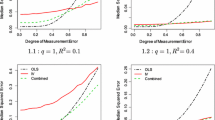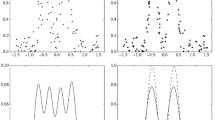Abstract
This paper considers a simple linear regression with two-way error component disturbances and derives the conditional relative efficiency ofany feasible GLS estimator with respect to OLS, true GLS, orany other feasible GLS estimator, conditional on the estimated variance components. This is done at two crucial choices of the x variable. The first choice is where OLS is least efficient with respect to GLS and the second choice is where an arbitrary feasible GLS estimator is least efficient with respect to GLS. Our findings indicate that a better guess of a certain ‘variance components ratio’ leads to better estimates of the regression coefficients.
Similar content being viewed by others
References
Amemiya, T. (1971), “The Estimation of Variances in a Variance-Components Model,”International Economic Review, 12: 1–13.
Balestra, P. (1973), “Best Quadratic, Unbiased Estimators of the Variance-Covariance Matrix in Normal Regression,”Journal of Econometrics, 2: 17–28.
Balestra, P. and Nerlove, M. (1966), “Pooling Cross-Section and Time-Series Data in the Estimation of a Dynamic Model: The Demand for Natural Gas,”Econometrica, 34: 585–612.
Baltagi, B. H. (1981), “Pooling: An Experimental Study of Alternative Testing and Estimation Procedures in a Two-way Error Components Model,”Journal of Econometrics, 17: 21–49.
Baltagi, B. H. (1986), “Pooling Under Misspecification: Some Monte Carlo Evidence on the Kmenta Versus the Error Components Technique,”Econometric Theory, 2: 429–440.
Baltagi, B. H. and Griffin, J. M. (1983), “Gasoline Demand in the OECD: An Application of Pooling and Testing Procedures,”European Economic Review, 22: 117–137.
Baltagi, B. H. and Griffin, J. M. (1988), “A Generalized Error Component Model With Heteroskedastic Disturbances,”International Economic Review, 29: 745–753.
Bloomfield, P. and Watson, G. S. (1975), “The Inefficiency of Least Squares,”Biometrika, 62: 121–128.
Breusch, T. (1987), “Maximum Likelihood Estimation of Random Effects Models,”Journal of Econometrics, 36: 383–389.
Dielman, T. E. (1983), “Pooled Cross-Sectional and Time Series Data: A Survey of Current Statistical Methodology,”The American Statistician, 37: 111–112.
Fuller, W. A. and Battese, G. E. (1974), “Estimation of Linear Models With Cross-Error Structure,”Journal of Econometrics, 2: 67–78.
Golub, G. H. (1963), “Comparison of the Variance of Minimum Variance and Weighted Least Squares Regression Coefficients,”Annal of Mathematical Statistics, 34: 984–991.
Hausman, J. A. (1978), “Specification Tests in Econometrics”,Econometrica, 46: 1251–1271.
Hsiao, C. (1986)Analysis of Panel Data, (Cambridge University Press, New York).
Hylton, K. (1985), “A Note on the Inefficiency of Non-Linear Estimators,”Economics Letters, 17: 347–350.
Khatri, C. G. and Rao, C. R. (1982), “Some Generalizations of Kantorovich Inequality,”Sankhya, 44: 91–102.
Knott, M. (1975), “On the Minimum Efficiency of Least Squares,”Biometrika, 62: 129–132.
Maddala, G. S. (1971), “The Use of Variance Components Models in Pooling Cross Section and Time Series Data,”Econometrica, 39: 341–358.
Maddala, G. S. and Mount, T. D. (1973), “A Comparative Study of Alternative Estimators for Variance Components Models Used in Econometric Applications,”Journal of the American Statistical Association, 68: 324–8.
Mundlak, Y. (1978), “On the Pooling of Time Series and Cross-Section Data,”Econometrica, 46: 69–85.
Nerlove, M. (1971), “A Note on Error Components Model,”Econometrica, 39: 383–396.
Prucha, I. R. (1984), “On the Asymptotic Efficiency of Feasible Aitken Estimators for Seemingly Unrelated Regression Models with Error Components,”Econometrica, 52: 203–207.
Rao, C. R. (1972), “Estimating Variance and Covariance Components in Linear Models,”Journal of the American Statistical Association, 67: 112–115.
Searle, S. R. and H. V. Henderson (1979), “Dispersion Matrices for Variance Components Models,”Journal of the American Statistical Association, 74: 465–470.
Swamy, P. A. V. B. (1971),Statistical Inference in Random Coefficient Regression Models, (Springer-Verlag, New York).
Swamy, P. A. V. B. and S. S. Arora (1972), “The Exact Finite Sample Properties of the Estimates Components Regression Models,”Econometrica, 40: 261–275.
Taylor, W. E. (1980), “Small Sample Considerations in Estimation From Panel Data,”Journal of Econometrics, 13: 203–223.
Wallace, T. D. and A. Hussain (1969), “The Use of Error Components Models in Combining Cross Section with Time Series Data,”Econometrica, 37: 55–72.
Wansbeek, T. and A. Kapteyn (1982), “A Simple Way to Obtain the Spectral Decomposition of Variance Components Models for Balanced Data,”Communication in Statistics, A11: 2105–2112.
Wansbeek, T. and A. Kapteyn (1983), “A Note on Spectral Decomposition and Maximum Likelihood Estimation in ANOVA Models with Balanced Data,”Statistics and Probability Letters, 1: 213–215.
Watson, G. S. (1967), “Linear Least Squares Regression,”Annals of Mathematical Statistics, 38: 1679–1699.
Author information
Authors and Affiliations
Rights and permissions
About this article
Cite this article
Baltagi, B.H. The error components regression model: conditional relative efficiency comparisons. Statistical Papers 31, 1–13 (1990). https://doi.org/10.1007/BF02924669
Received:
Revised:
Issue Date:
DOI: https://doi.org/10.1007/BF02924669




